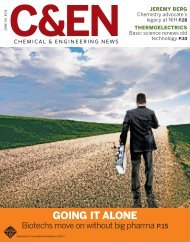Chemical & Engineering News Digital Edition - Institute of Materia ...
Chemical & Engineering News Digital Edition - Institute of Materia ...
Chemical & Engineering News Digital Edition - Institute of Materia ...
Create successful ePaper yourself
Turn your PDF publications into a flip-book with our unique Google optimized e-Paper software.
COURTING JAPAN<br />
CPhI JAPAN: Foreign suppliers<br />
<strong>of</strong> pharmaceutical chemicals affirm<br />
commitment to country’s market<br />
LIKE PATIENT SUITORS, suppliers <strong>of</strong> active<br />
pharmaceutical ingredients (APIs) and intermediates<br />
are undeterred in courting Japanese drug<br />
companies. Last week in Tokyo, exhibitors at the fine<br />
chemicals trade show CPhI Japan suggested that those<br />
pharma companies’ resistance to dealing with foreign<br />
suppliers is diminishing.<br />
Japanese pharma traditionally has been conservative<br />
in sourcing ingredients. Although not unknown, reliance<br />
on parties beyond a small circle <strong>of</strong> suppliers was rare.<br />
Changes in Japan’s regulations, however, raised outsiders’<br />
hopes <strong>of</strong> breaking through the circle (C&EN, May 15,<br />
2006, page 29). That hasn’t happened as quickly as outsiders<br />
had anticipated, but they are not discouraged.<br />
Takuya Yamamoto, <strong>of</strong> trading company Koa Shoji,<br />
said drug companies are still looking at the same suppliers,<br />
but he expects the pool to increase eventually. Similarly,<br />
Jagmohan M. Khanna, <strong>of</strong> Indian contract manufacturer<br />
Jubilant Organosys, predicted that “the Japanese<br />
market is going to open up gradually because <strong>of</strong> costs.”<br />
According to Yamamoto, Europeans have an edge<br />
among foreign suppliers. “They already know about<br />
quality and are easy to trust,” he said. They are also famil-<br />
JUNGLE SKY<br />
AIR CHEMISTRY: Forest air can do more<br />
oxidizing than previously thought<br />
LONG-HELD BELIEFS about the chemical makeup<br />
<strong>of</strong> the atmosphere above pristine rain forests<br />
are being called into question by new research<br />
that could inform air pollution modeling and regulation<br />
in areas that are more urban.<br />
All forms <strong>of</strong> foliage emit vast amounts <strong>of</strong> hydrocarbons<br />
into the sky, far more than cars do. In fact, trees<br />
and plants expel about 500 billion kg <strong>of</strong> isoprene per<br />
year—which is approximately the combined weight <strong>of</strong><br />
every human in the world. But the atmospheric lifetime<br />
<strong>of</strong> these hydrocarbons is just a few hours, much shorter<br />
than that <strong>of</strong> anthropogenic hydrocarbons, says Jonathan<br />
Williams, an atmospheric scientist at Max Planck<br />
<strong>Institute</strong> for Chemistry in Mainz, Germany.<br />
Near urban centers, isoprene reacts with polluting<br />
nitrogen oxides to form smog. Researchers have long<br />
thought that above pristine jungles and forests, isoprene<br />
is oxidized by hydroxyl radicals, thereby depleting<br />
the overall oxidative potential <strong>of</strong> jungle skies.<br />
NEWS OF THE WEEK<br />
iar with drug master<br />
files, the data that<br />
Japanese law now<br />
requires companies<br />
to submit for APIs.<br />
European firms<br />
themselves tout<br />
these qualities: regulatory<br />
experience,<br />
reliability, and a<br />
deep understanding<br />
<strong>of</strong> quality’s primacy.<br />
As Wilhelm Stahl,<br />
head <strong>of</strong> Saltigo’s pharma business, put it, “If you have<br />
quality issues, you have a big mess.” Still, Stahl admitted<br />
that breaking through in Japan will take time. “With<br />
Japan, one has to take a long-term view,” he said.<br />
Because <strong>of</strong> difficulties that can arise from cultural<br />
differences, Japanese will always prefer to work with<br />
Japanese, contended Ichiro Shinkai, <strong>of</strong> Beta-Chem, a<br />
chemical development arm <strong>of</strong> Mitsui & Co. Foreigners<br />
would do well to adapt Japanese business ways, he said.<br />
Almac, a Northern Irish pharma services firm, heeds<br />
the advice. Companies can fail in Japan for boorishness,<br />
according to David Moody, vice president <strong>of</strong><br />
commercial operations. Almac has made inroads in the<br />
country partly through the respectful demeanor <strong>of</strong> the<br />
people it sends there, he claimed. The cultural sensitivity<br />
has reaped projects that are small but have growth<br />
potential, added Rosaleen McGuckin, vice president <strong>of</strong><br />
business development.—MAUREEN ROUHI<br />
But when Williams, Jos Lelieveld, and their colleagues<br />
from Max Planck <strong>Institute</strong> for Chemistry sent a<br />
Lear jet packed full <strong>of</strong> equipment over South American<br />
jungles, they found that OH radicals are not depleted<br />
at all but exist at the same concentrations as over the<br />
oceans. The authors suggest that hydroxyl radicals are,<br />
in fact, being recycled, not used up, by jungle-emitted<br />
isoprene (Nature 2008, 452, 737).<br />
“Jungles rely on an oxidative atmosphere to create<br />
the concentration gradients required for chemical<br />
ecology to work”—so a pollinating insect can hone in<br />
on nectar in a flower, for example, Williams says. “It’s<br />
amazing that the jungle can maintain levels <strong>of</strong> HO∂”<br />
required for a healthy ecosystem.<br />
The new findings also call into question models that<br />
air pollution regulators have been using to estimate<br />
the levels <strong>of</strong> smog and ozone in forested areas downwind<br />
<strong>of</strong> urban nitric oxide emissions, comments Alex<br />
Guenther, a senior scientist with the National Center<br />
for Atmospheric Research, in Boulder, Colo. “Hydroxyl<br />
radicals are critical compounds in the air, but they are<br />
also really hard to measure,” Guenther says. “When the<br />
concentration <strong>of</strong> HO∂ changes, the concentration <strong>of</strong><br />
everything in numerical models changes.” Regulators<br />
should, therefore, pay close attention to these findings,<br />
he notes.—SARAH EVERTS<br />
WWW.CEN-ONLINE.ORG 13 APRIL 14, 2008<br />
CPhI Japan attracted<br />
about 15,000 visitors,<br />
organizers say.<br />
ALEX GUENTHER/© 2008 NATURE<br />
The air above South<br />
American forests is<br />
more oxidative than<br />
previously thought.<br />
MAUREEN ROUHI/C&EN

















